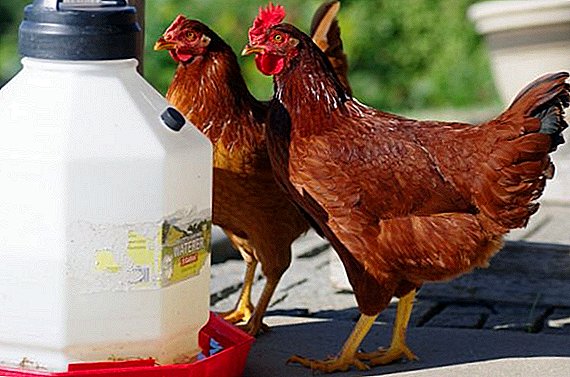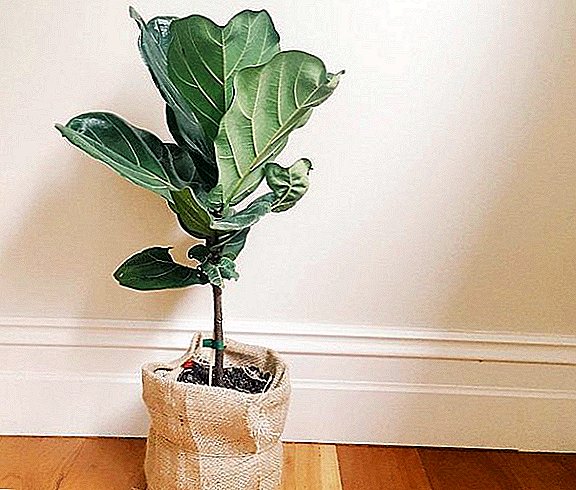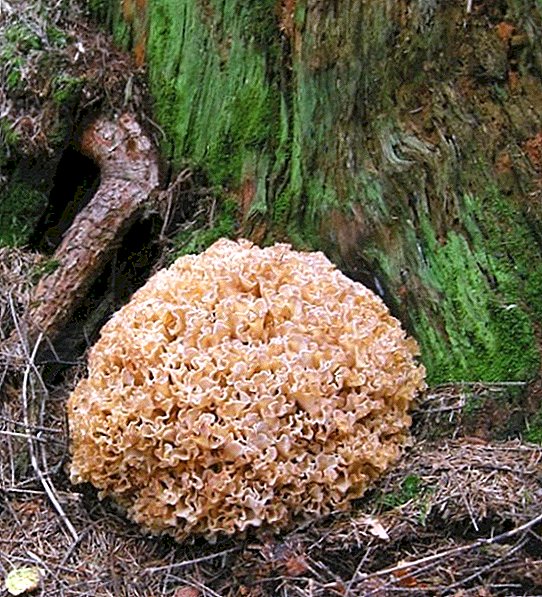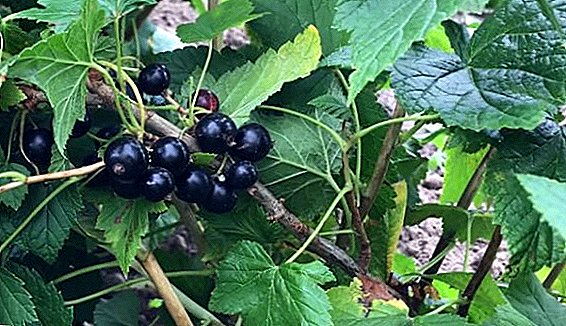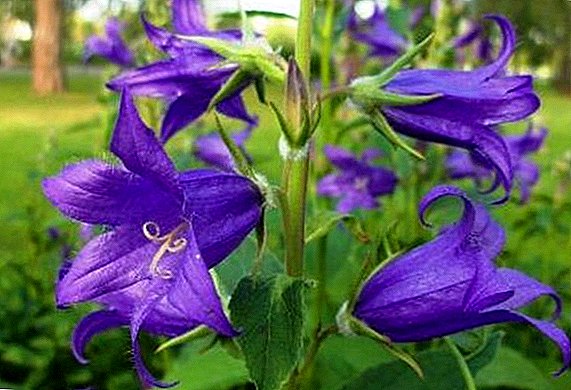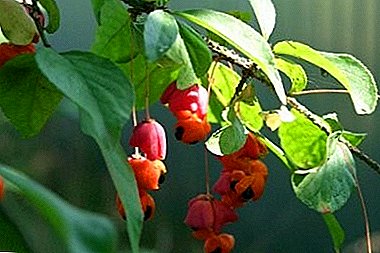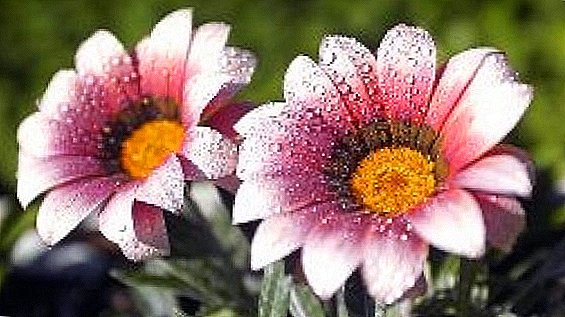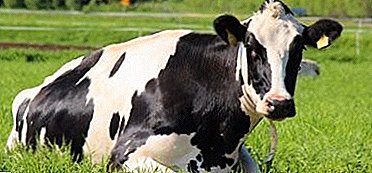 In our latitudes, broccoli began to be planted and eaten not so long ago. However, this vegetable is rapidly gaining popularity, which lies in its usefulness, taste and low-calorie content.
In our latitudes, broccoli began to be planted and eaten not so long ago. However, this vegetable is rapidly gaining popularity, which lies in its usefulness, taste and low-calorie content.
To its advantages, you can add even simplicity in the care. Let's figure out how to grow broccoli in the garden.
Variety selection
Broccoli is a vegetable plant belonging to the cabbage family, is a type of garden cabbage. It is also called asparagus cabbage. The stem of the plant reaches a height of 60-90 cm. At its end, flower stalks are formed.
There are a lot of cabbage varieties. Check out some of them: Kohlrabi, Beijing, color, Brussels, Savoy, Kale.
The vegetable is grown for human consumption - like cauliflower, broccoli in culinary use not leaves, but unblown inflorescences. They are consumed raw in salads, boiled, fried, steamed, added to first courses, omelets, pies. Broccoli goes well with meat, fish, mushrooms, and other vegetables.
When growing a vegetable plant is not necessary. Withstands prolonged droughts, short-term high temperatures, resistant to cold. Today, over 200 varieties and hybrids of asparagus cabbage have been bred, among which there are early-ripening, mid-ripening and late-ripening. We will tell you about the top 10 broccoli varieties for the middle band.
- Variety "Tonus". Early, aging time - 80-90 days. Its inflorescences are of medium density. The heads reach a mass of 200 g. The variety is well suited for salads and canning. Not suitable for long-term storage. Vegetable safely tolerates temperature extremes, resistant to disease.
- Grade "Fiesta". Treats grades with the fast period of maturing - matures in 70 days. The head is formed one, weighing 300 g. Unlike other varieties, the "Fiesta" does not produce side branches. The structure is dense and very juicy.
Important! Early ripe varieties of broccoli can be stored no more than two weeks in the refrigerator. If you eat vegetables after the specified period, food poisoning is possible..
- Sort "Linda".The early ripe hybrid which period of maturing makes 75-80 days. The heads of this variety are rather large - 350-400 g each. Inflorescences are soft, good for fresh consumption.
- Variety "Dwarf". Mid-season, the aging period is 120 days. The landing period is mid-May. Fruits are large: the main ones have an average weight of 400-600 g, lateral - 200 g. Suitable for long-term storage (about one month) and canning.
- Variety "Vyarus". It matures quickly in just 50 days. The average head weight is 300-350 g. The fruits have an average density. After cleaning the main head grow up to seven side branches. Can be planted both in summer and in autumn.
- Variety "Comanche". Ready to eat three months after planting. Head sizes are large - up to 300-350 g. They are distinguished by increased density and good transportability. Variety tolerates cold and heat.
- Variety "Arcadia F1". Early ripe hybrid. Forms the average density of the head, excellent taste. The hybrid is characterized by good yield and resistance to low temperatures.
- Variety "Monterey F1". Mid-season hybrid. Forms a very large head - up to 2 kg, but only the main, does not give side branches. Hybrid frost resistant.
- Variety "Calabrese". Refers to mid-season varieties. Forms a dense, large head - up to 400 g, which is suitable for freezing and marinating.
- Variety "Corvette". The hybrid that has the highest rate of ripening is two months. Forms large and dense fruits. After cutting the main head gives a lot of lateral processes. Resistant to adverse weather conditions. Vegetable can be eaten fresh and frozen for consumption in winter.






Did you know? Broccoli is a negative calorie food. This means that the body spends more energy on its absorption than it receives as a result of eating it. 100 g of cabbage contains 30 kcal.
Growing broccoli seedlings
After choosing a broccoli variety, you need to take care of its proper planting and care in the open field. Planted vegetable in two ways:
- rassadnym;
- bezrassadnym.
Best time
The best time to plant broccoli seeds for seedlings is the first half of March. Sprouts should be planted in open ground at the age of 30-45 days, i.e. in early to mid-April. From late April-early May, cabbage can already be planted in a seedless way. 
Soil and capacity for seedlings
For sowing seeds will need a box with a height of at least 25 cm. The bottom of it should be covered with a layer of drainage. The substrate for planting is prepared from the following components:
- turf ground;
- sand;
- humus;
- ash.
Seed preparation
Before sowing broccoli for seedlings, the seeds should be sorted and discarded. The largest ones are selected for sowing. They are placed for 15-20 minutes in hot water. After this time, the seeds are dipped in cold water.  After this procedure, seed for 12 hours should be placed in the drug "Epin." Then rinse with water, dry and send to the fridge for a day.
After this procedure, seed for 12 hours should be placed in the drug "Epin." Then rinse with water, dry and send to the fridge for a day.
Another way to prepare seeds is to put potassium permanganate in a solution for half an hour, rinse with water, and treat with Albit, Agat-21, El-1 or other preparations similar in action.
Did you know? It is believed that broccoli never grew in the wild. It was obtained as a result of hybridization. Grown in the VI-V centuries BC. er in the Mediterranean. Throughout the world, the vegetable began to spread only a few centuries later.
Sowing seeds for seedlings
Before sowing the soil should be watered well. For seeds, make holes 1-1.5 cm deep, keeping a distance of 3 cm between them. Put seeds into the wells and lightly sprinkle them with soil, which is then tamped.
Sprouting conditions
In the room where the seedlings germinate, the temperature should be maintained at 20 ° C. After the first shoots appear, the temperature is lowered to + 10 ° С. Then they adhere to such temperature conditions: if the weather is sunny, then the mark on the thermometer should be at + 16 ° С, in the absence of the sun - + 14 ° С.  Also, for good and fast germination of seedlings, high humidity is necessary - not less than 70% and regular, but not abundant watering. The soil must be constantly moist, but not flooded, otherwise seedlings can hit the disease blackleg.
Also, for good and fast germination of seedlings, high humidity is necessary - not less than 70% and regular, but not abundant watering. The soil must be constantly moist, but not flooded, otherwise seedlings can hit the disease blackleg.
Seedling care
At two weeks of age, the seedlings will need to dive. To do this, use disposable cups or peat pots. The latter option is more optimal, since in peat pots, seedlings can immediately be planted in open ground.
After the picking procedure, the seedlings will need to be sheltered for several days from the sun and maintained in a room with a temperature of 21 ° C.
After the seedlings take root, the daytime temperature should be lowered to 17 ° C, and nighttime to 9 ° C. 
Hardening seedlings
In order for the plant to grow strong and have excellent immunity, the shoots will need to be hardened, starting two weeks before the period of disembarking them to a permanent place. For several hours a day, seedlings are carried out on the street or an open balcony. Every day hardening time increase.
Important! Starting from April, seedlings can be grown in open ground under a non-woven cover and plastic film. Sprouts can withstand frosts down to -7 ° C. Non-woven material will protect them from the invasion of the cruciferous flea.
Planting seedlings in open ground
Young seedlings will need to be transplanted to a permanent place, correctly calculating the time and choosing a place.
Best time
Seedlings should be 30-45 days old and have 4-5 full leaves, as well as good roots. Usually, the period when it is ready to move to a permanent place begins in mid-May. However, everything will depend on weather conditions. If the warm weather is not yet fully established, and frosts are constantly observed at night, in order to avoid undesirable consequences, planting sprouts should be postponed. 
The choice of location: lighting, soil, predecessors
Broccoli loves the sun, so for its landing choose a well-lit area, sheltered from the winds.
It is advisable to take care of the soil composition in advance. In the autumn, limestone, manure, potassium nitrate and organic matter in the form of manure are introduced into the open ground cultivation site of broccoli cabbage growing. If this was not done, then in the spring, humus (1 bucket / 1 sq. M), superphosphate (2 tablespoons), urea (1 teaspoon) and ash (2 cups) are added to each landing hole, mixing them with the ground.  For any cabbage, and broccoli is no exception, it is important to choose a place with the right precursors to prevent infection by diseases and pests. These include:
For any cabbage, and broccoli is no exception, it is important to choose a place with the right precursors to prevent infection by diseases and pests. These include:
- carrot;
- potatoes;
- siderats;
- legumes;
- cucumbers;
- bow;
- cereals.
- cabbage;
- radishes;
- tomatoes;
- turnips;
- beets.
Optimal scheme
It is desirable to transplant seedlings in open ground in the absence of the sun outside - in cloudy weather or in the evening. The optimal landing scheme is 35x60.
Sprouts do not deepen much - only up to the first leaflet, about 1 cm. Good watering of the planting, it is desirable to mulch the soil - this will preserve the necessary moisture and protect the soil from weeds.
Care for broccoli in the open field
 Broccoli care will be traditional, just like any vegetable crop. Among the activities should be regular watering, loosening, cleaning weeds, hilling bushes, fertilizing and preventive measures against diseases and parasites.
Broccoli care will be traditional, just like any vegetable crop. Among the activities should be regular watering, loosening, cleaning weeds, hilling bushes, fertilizing and preventive measures against diseases and parasites.
Watering, weeding and loosening
Asparagus cabbage is very moisture-loving. It is advised to water it at least once every seven days, but the ideal amount would be one watering in 2-3 days. It is better to do this in the evening, so as not to provoke burns. In hot weather, the frequency of irrigation should be reduced to twice a day. Spraying will also be helpful.
You must ensure that the layer depth of 15 cm is not dry. Each watering should take place simultaneously with the loosening of the soil. Loosening depth - 8 cm.
If the soil is not mulched, then weeding should also be included in regular activities. To destroy weeds should be both near the cabbage head, and in close proximity. 
Hilling bushes
20 days after the young growth has been planted in open ground, broccoli should be mined. Hilling is carried out simultaneously with loosening the soil.
The second hilling will be needed after 10 days. This procedure will help to form more lateral processes.
Fertilization
The secret to getting a good harvest and large heads lies in regular and proper feeding.
About 3-4 weeks after planting, when the vegetable is already well established, it is time to apply the first fertilizer. The first time it is better to fertilize with organic matter. Suitable cow dung (one part per 10 liters of water) or chicken manure (1:20).
The second feeding is done after two weeks. The third is done during the formation of inflorescences. Apply the solution in 10 liters of water superphosphate (40 g), sodium ammonium (20 g), potassium sulfate (10 g).  In those varieties where side shoots can be formed after cutting the main head, their growth can be stimulated by feeding the plant with potassium sulfate (30 g), superphosphate (20 g), and ammonium nitrate (10 g) dissolved in 10 l of water.
In those varieties where side shoots can be formed after cutting the main head, their growth can be stimulated by feeding the plant with potassium sulfate (30 g), superphosphate (20 g), and ammonium nitrate (10 g) dissolved in 10 l of water.
It is also good to periodically dust the plant with wood ash. This procedure will have a double effect: will serve as a fertilizer and will protect against pests.
Preventive treatment
Like any other cabbage, broccoli has many enemies in the form of pathogens and pests.
The most common disease is the kela. To prevent it, it is necessary to follow the recommendations on crop rotation and the distance between sprouts during planting - plantings should not be thickened. You also need to plant potatoes, tomatoes, peppers, garlic, eggplants in the immediate vicinity.
Young plantings can hit the black leg. For prevention, they are treated with "Fitosporin", "Baktofit" and other similar drugs.  Also, broccoli can affect downy mildew and slimy bacteriosis. It is necessary to disinfect the seeds before planting. When powdery mildew will help wood ash, a mixture of lime and sulfur, the drug "Topaz".
Also, broccoli can affect downy mildew and slimy bacteriosis. It is necessary to disinfect the seeds before planting. When powdery mildew will help wood ash, a mixture of lime and sulfur, the drug "Topaz".
To avoid damage to the linen, apply spraying copper-containing drugs.
Of the most dangerous pests are cruciferous flea, capable of completely destroying young plants. To prevent their invasion, it is necessary to cover the still fragile landing non-woven cloth. You can also sprinkle the soil around asparagus cabbage with ash, tobacco dust, pepper, to scare off pests. You can use water infusions of these natural insecticides. Also, before the formation of inflorescences, it is possible to use the preparation "Iskra", "Aktellik", "Foxima".  Broccoli can attack slugs. So that they do not harm the plant, you need to chop the eggshell and scatter it between plantings.
Broccoli can attack slugs. So that they do not harm the plant, you need to chop the eggshell and scatter it between plantings.
The appearance of aphids can be prevented by spraying infusions from insecticidal plants, for example, potato tops, with the ash-and-soap mixture. In the case of a massive defeat, they resort to treatments by "Aktellik" and "Iskra-bio".
Cabbage fly will go away if processed by Corsair, Ambush, Rovikurt.
Harvesting and storage of the crop
2-3 months after planting (the term depends on the selected variety), the asparagus cabbage forms inflorescence heads. The period of their maturation is very rapid - in 2-3 days they will need to be cut off so that they do not bloom.
After pruning the main head in a few days, smaller side processes will grow, which are also edible. It is better to cut off inflorescences in the morning.  The storage time for broccoli will depend on the variety. Early varieties are not suitable for long-term storage. They can be stored for a maximum of 7-10 days in the refrigerator.
The storage time for broccoli will depend on the variety. Early varieties are not suitable for long-term storage. They can be stored for a maximum of 7-10 days in the refrigerator.
Early and late ripening varieties collected in the fall can be stored longer - about three months in the cellar or in the refrigerator.
To save the crop in the winter, it will need to be frozen. Frozen broccoli will not lose its beneficial qualities.
Did you know? Broccoli contains a large amount of vitamin C - 89.2 mg per 100 g, which is 90% of the daily requirement for the human body. However, when storing a vegetable without a refrigerator for several days, the amount of ascorbic acid is halved.Growing broccoli is very simple, no special effort is required. With the right choice of varieties, compliance with the recommended agrotechnical measures within 2-3 months after planting, a healthy, tasty and low-calorie product will be on your table.


